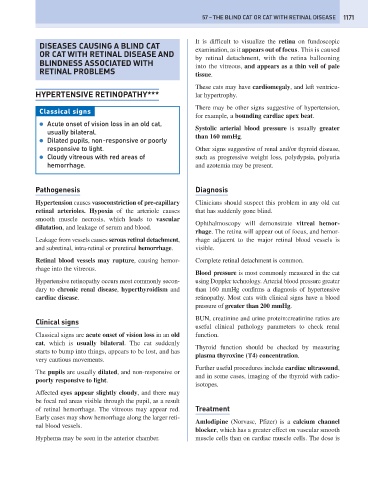Page 1179 - Problem-Based Feline Medicine
P. 1179
57 – THE BLIND CAT OR CAT WITH RETINAL DISEASE 1171
It is difficult to visualize the retina on fundoscopic
DISEASES CAUSING A BLIND CAT examination, as it appears out of focus. This is caused
OR CAT WITH RETINAL DISEASE AND by retinal detachment, with the retina ballooning
BLINDNESS ASSOCIATED WITH into the vitreous, and appears as a thin veil of pale
RETINAL PROBLEMS tissue.
These cats may have cardiomegaly, and left ventricu-
HYPERTENSIVE RETINOPATHY*** lar hypertrophy.
There may be other signs suggestive of hypertension,
Classical signs
for example, a bounding cardiac apex beat.
● Acute onset of vision loss in an old cat,
Systolic arterial blood pressure is usually greater
usually bilateral.
than 160 mmHg.
● Dilated pupils, non-responsive or poorly
responsive to light. Other signs suggestive of renal and/or thyroid disease,
● Cloudy vitreous with red areas of such as progressive weight loss, polydypsia, polyuria
hemorrhage. and azotemia may be present.
Pathogenesis Diagnosis
Hypertension causes vasoconstriction of pre-capillary Clinicians should suspect this problem in any old cat
retinal arterioles. Hypoxia of the arteriole causes that has suddenly gone blind.
smooth muscle necrosis, which leads to vascular
Ophthalmoscopy will demonstrate vitreal hemor-
dilatation, and leakage of serum and blood.
rhage. The retina will appear out of focus, and hemor-
Leakage from vessels causes serous retinal detachment, rhage adjacent to the major retinal blood vessels is
and subretinal, intra-retinal or preretinal hemorrhage. visible.
Retinal blood vessels may rupture, causing hemor- Complete retinal detachment is common.
rhage into the vitreous.
Blood pressure is most commonly measured in the cat
Hypertensive retinopathy occurs most commonly secon- using Doppler technology. Arterial blood pressure greater
dary to chronic renal disease, hyperthyroidism and than 160 mmHg confirms a diagnosis of hypertensive
cardiac disease. retinopathy. Most cats with clinical signs have a blood
pressure of greater than 200 mmHg.
BUN, creatinine and urine protein:creatinine ratios are
Clinical signs
useful clinical pathology parameters to check renal
Classical signs are acute onset of vision loss in an old function.
cat, which is usually bilateral. The cat suddenly
Thyroid function should be checked by measuring
starts to bump into things, appears to be lost, and has
plasma thyroxine (T4) concentration.
very cautious movements.
Further useful procedures include cardiac ultrasound,
The pupils are usually dilated, and non-responsive or
and in some cases, imaging of the thyroid with radio-
poorly responsive to light.
isotopes.
Affected eyes appear slightly cloudy, and there may
be focal red areas visible through the pupil, as a result
of retinal hemorrhage. The vitreous may appear red. Treatment
Early cases may show hemorrhage along the larger reti-
Amlodipine (Norvasc, Pfizer) is a calcium channel
nal blood vessels.
blocker, which has a greater effect on vascular smooth
Hyphema may be seen in the anterior chamber. muscle cells than on cardiac muscle cells. The dose is

